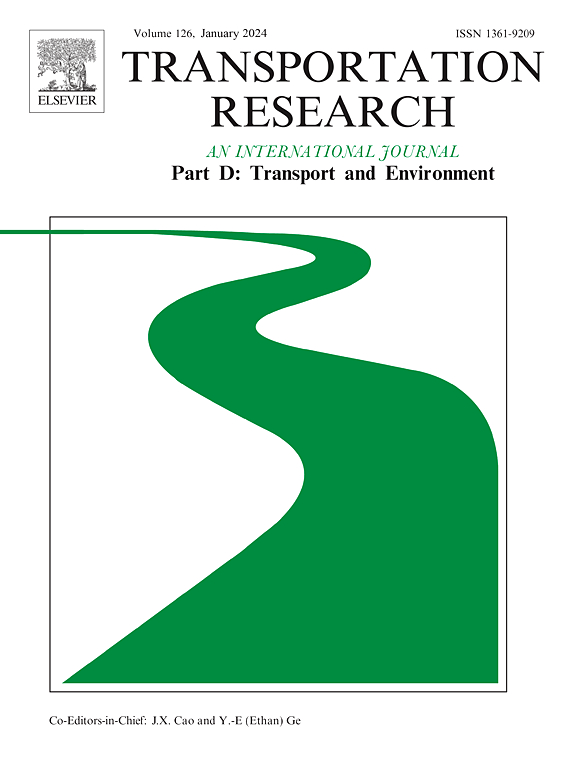Sustainable thermochromic coatings for pavement cooling and carbon offset under climate change
IF 7.7
1区 工程技术
Q1 ENVIRONMENTAL STUDIES
Transportation Research Part D-transport and Environment
Pub Date : 2025-09-25
DOI:10.1016/j.trd.2025.104995
引用次数: 0
Abstract
Under escalating climate change, asphalt pavements encounter aggravated heat-related burdens as surface temperatures climb beyond 65 °C, creating urgent demands for cooling solutions. This study develops a red thermochromic composite coating that provides temperature control for asphalt pavements while delivering carbon offset potential. Through comprehensive characterization of thermochromic and conventional red pigments, optimal combinations were identified. The optimized coating (75 % Thermochromic Red: 25 % Silicon Iron Red) demonstrates temperature-responsive behavior, transitioning from deep red (a* = 25.21, L* = 62.51) to lighter red (a* = 17.02, L* = 68.05) at high temperatures. This intelligent design achieves high baseline solar reflectance (71.36 % near-infrared and 37.80 % visible reflectance) with further enhancement when cooling is most needed. Field testing revealed 13.94 °C cooling effect in contrast to untreated asphalt concrete. Carbon offset analysis indicates that widespread implementation could theoretically offset approximately 60.52 Gt of CO2 emissions, providing a solution combining cooling benefits with climate mitigation potential.
气候变化下路面冷却和碳补偿的可持续热致变色涂料
在气候变化不断加剧的情况下,随着沥青路面表面温度攀升至65℃以上,沥青路面的热负担加重,对冷却解决方案的需求日益迫切。本研究开发了一种红色热致变色复合涂层,可为沥青路面提供温度控制,同时提供碳抵消潜力。通过对热致变色颜料和常规红颜料的综合表征,确定了最佳组合。优化后的涂层(75%热致变色红:25%硅铁红)表现出温度响应行为,在高温下从深红色(a* = 25.21, L* = 62.51)转变为浅红色(a* = 17.02, L* = 68.05)。该智能设计实现了高基线太阳反射率(71.36%的近红外反射率和37.80%的可见光反射率),并在最需要冷却时进一步增强。现场试验显示,与未经处理的沥青混凝土相比,其冷却效果为13.94℃。碳抵消分析表明,从理论上讲,广泛实施可抵消约6052亿吨二氧化碳排放,提供了一种将降温效益与气候缓解潜力结合起来的解决方案。
本文章由计算机程序翻译,如有差异,请以英文原文为准。
求助全文
约1分钟内获得全文
求助全文
来源期刊
CiteScore
14.40
自引率
9.20%
发文量
314
审稿时长
39 days
期刊介绍:
Transportation Research Part D: Transport and Environment focuses on original research exploring the environmental impacts of transportation, policy responses to these impacts, and their implications for transportation system design, planning, and management. The journal comprehensively covers the interaction between transportation and the environment, ranging from local effects on specific geographical areas to global implications such as natural resource depletion and atmospheric pollution.
We welcome research papers across all transportation modes, including maritime, air, and land transportation, assessing their environmental impacts broadly. Papers addressing both mobile aspects and transportation infrastructure are considered. The journal prioritizes empirical findings and policy responses of regulatory, planning, technical, or fiscal nature. Articles are policy-driven, accessible, and applicable to readers from diverse disciplines, emphasizing relevance and practicality. We encourage interdisciplinary submissions and welcome contributions from economically developing and advanced countries alike, reflecting our international orientation.

 求助内容:
求助内容: 应助结果提醒方式:
应助结果提醒方式:


